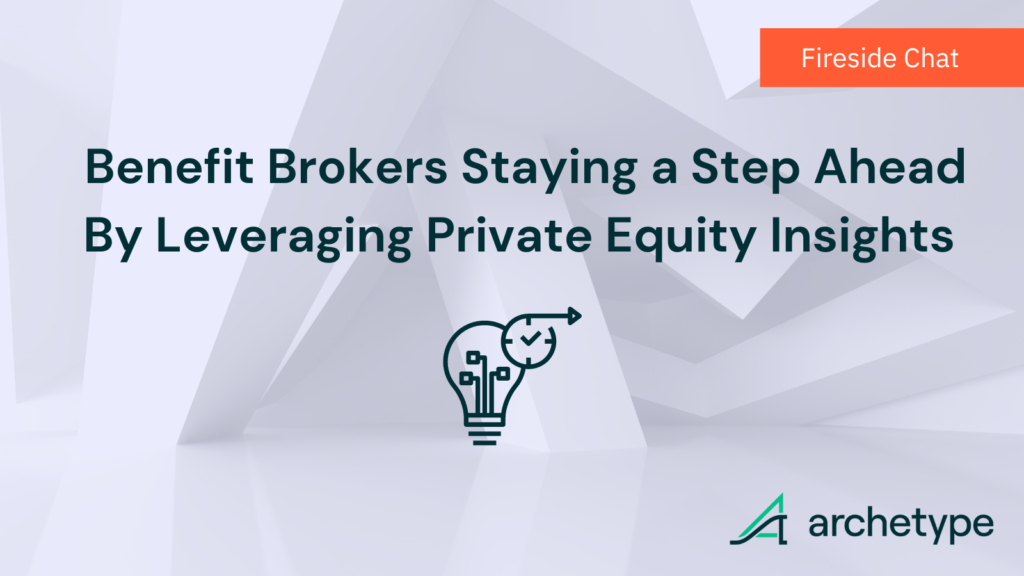Benefit Brokers Staying a Step Ahead By Leveraging Private Equity Insights
This blog is based on an interview of Tim Simokonis, Vice President of Lockton, and Steve Herman, Executive in Residence at Archetype, by Iain Fitzpatrick, Archetype’s Chief Strategy Officer for the Fireside Chat, “Bringing Together Benefit Brokers and Private Equity for a Lens into the Future. “
For many industries, 2022 has been a challenging year. The public markets have seen a 15 to 20% decline in the major indexes. Experts estimate that private market evaluations in 2023 will begin to underperform the public market indexes. In the wake of a predicted recession, many employers are faced with difficult decisions regarding layoffs and employee retention.
In addition, healthcare broker firms are seeing the impact of this macroeconomic climate through their clients’ hospital and cost-of-care claims. Tim Simokonis, Vice President of Lockton, the world’s largest independent insurance brokerage, shares, “our clients’ medical claims are probably the highest we’ve seen in years.” Employers continue to be challenged by the COVID-19 pandemic, which resulted in delayed care, while also experiencing record levels of attrition and rising healthcare costs that are outpacing inflation. According to the Kaiser Family Foundation, “Between 2011 and 2021, insurance premiums for families covered by employer-sponsored plans increased 47% – outpacing inflation by 23% and wage growth by 30%. In this environment, employers are trying to simultaneously expand benefits and manage healthcare costs.
Benefit Brokers Must Rise to the Challenge
Simokonis reflects, “Everyone is looking at everything under a microscope. Cost is king. How do we save costs while improving care? That is what’s on everyone’s mind right now in the marketplace.” This hyper-focus on costs has forced the broker industry to become hyper-aware of the new and innovative point solutions available in the marketplace. There are many vendors and start-ups that claim to have the newest solution to fit your client’s needs. The broker’s responsibility is to ensure your client is making an informed decision that meets their business goals as well as the needs of their employees.
According to MetLife’s 15th Annual US Employee Benefits Trend Study, brokers continue to be a valuable resource to employers of all sizes. When asked how significant an impact outside professionals or firms had on employee benefits selection during the renewal process, 81% said an insurance agent or broker played a role. In addition, 75% said an employee benefits consultant or consulting firm played a role.
The challenge for today’s brokers is to keep up with the client demand for new solutions by presenting vetted solutions that are on the leading edge and not the bleeding edge of technology. According to Simokonis, “There’s so many new vendors in terms of point solutions trying to solve the healthcare crisis costs and access for employees and employers. It’s been tough to filter through many of these new and innovative solutions. But we’re careful about the solutions we bring to our clients. We make sure they are properly vetted. When our clients hire us as a trusted advisor, the expectation is that we will not do anything to put them in harm’s way. But you have to be cutting edge with some of the solutions because if you’re not bringing them to your clients, someone else is.”
The Intersection of Private Equity and Benefits Brokers
Private equity (PE) interest in the healthcare sector is at an all-time high, spurred by the digital health revolution, value-based care, and increased demand for consumer-driven services. This interest creates a unique intersection for the broker space. Proper due diligence and research must be in place before a PE firm invests in a new venture. Brokers have the opportunity to leverage this market research to be on the cutting edge for their clients.
Archetype, a Philadelphia-based consulting and investment firm with a focus on workplace health and performance sectors, recognized the gap within the broker space. In 2022, Archetype created the RAD Collective, which stands for Rare Advisor Drive, to help benefit consultants become more attractive in the marketplace. Steve Herman, Archetype’s Executive in Residence, describes the RAD Collective as a “curated group of high achievers, aimed at helping solve relevant industry challenges and to make a meaningful impact on the industry. As a result, Archetype gains a strong understanding of what’s happening in the industry, while the members gain visibility into new trends centered around innovation.”
As one of the founding members of the RAD Collective, Simokonis has been able to leverage his membership by easing the burden of vetting the many point solutions within the marketplace. “Having a relationship with the RAD Collective helps to qualify some of the solutions, and it’s been a huge help.” It’s no secret that the broker industry is competitive. However, the RAD Collective has brought together over 20 national brokerages by focusing on the bigger picture and working collaboratively to impact the benefits broker industry and its clients. Members have the opportunity to share their challenges, collaborate with fellow industry professionals, and stay ahead of the market with access to the latest tools, strategies, and resources.
To learn more about the RAD Collective and the intersection of private equity and benefit brokers, visit https://www.radcollective.com/.
Want to Learn More about How Benefit Brokers and Private Equity Can Leverage Each Other for a Lens Into the Future?
Watch the full webinar with Tim Simokonis, Steve Herman, and Iain Fitzpatrick.
